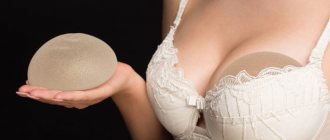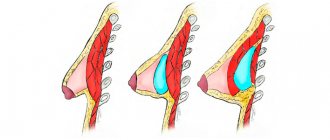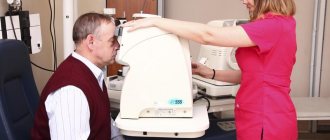Asymmetrical breasts of different sizes are one of the most common phenomena. According to statistics, 90% of girls have a difference between the right and left mammary glands, and in 45% the bust size differs by half a standard cup. Another question is how to approach this? Some people notice this difference and feel complex, while others perceive it as a common occurrence and do not pay attention.
So what to do if your breasts are different sizes? Let's figure it out.
Why do breasts come in different sizes?
True asymmetry, when breasts are different sizes and differ from each other by one cup. The reasons can be very diverse. They can be divided into 2 groups.
Congenital causes:
- hypoplasia (delayed development) of glandular tissue
- Poland syndrome is a congenital disease characterized by atrophy of the pectoralis major muscle
- hormonal problems during puberty
- micromastia - one mammary gland is significantly reduced in size compared to the other
- problems with the endocrine system
- prolonged incorrect body position, which leads to poor posture
- hereditary predisposition
- individual feature
Typically, congenital breast asymmetry is noticeable in girls aged 9-10 years. During this period, the ovaries already produce the hormones estrogen and progesterone, which are responsible for the development of glandular tissue. The bust can become disproportionate if hormones are in short supply or excess. If there is disproportionality, then you need to contact an endocrinologist or mammologist. Usually this problem is leveled out by the age of 18-19. If it persists into adulthood, then it can only be corrected by a plastic surgeon.
Acquired reasons:
- Breast-feeding. In this case, breast asymmetry is the so-called post-lactation involution of the mammary gland, which also manifests itself in disproportion. It depends on hormonal changes, and not on the duration of lactation, as many young mothers think. However, asymmetry can actually develop if you feed your baby on only one side.
- Mastopathy (fibroadenomatosis). Benign breast tumor. A characteristic sign of mastopathy is palpable lumps in the breast. The main reason is hormonal imbalance. Often, all types of mastopathy lead to visible asymmetry.
- Neoplasms. After their removal, the breast requires restoration.
- Sagging and drooping breasts. With age, the mammary gland loses elasticity and volume, and the muscles become less elastic. Because of this, the bust loses its former attractiveness and symmetry. This often happens when a woman crosses the threshold of menopause.
- Chest injuries. At risk are female athletes who play basketball, volleyball and other sports where there is a risk of physical injury.
Etiology
All reasons for the development of asymmetry can be divided into two large categories - congenital and acquired.
Congenital causes:
- genetic disorders;
- fetal malformations;
- fetal trauma.
Acquired reasons:
- hormonal diseases;
- consequences of surgical operations for partial or complete mastectomy;
- consequences of surgical infection of the mammary glands;
- the result of aesthetic breast surgery;
- breast injuries;
- age-related changes;
- neoplasms;
- lactation changes;
- problems with posture.
These factors can lead to uneven growth, enlargement or underdevelopment of one organ in relation to another, asymmetry of the areolas, as well as discrepancy between the glands in shape and size.
Classification of breast asymmetry
It is important to understand: there is no absolute symmetry - people are asymmetrical. Our right and left sides of our faces, legs, arms and, of course, chest are different. This is absolutely normal. A pathological fixation on symmetry often results in complexes and self-doubt.
We can talk about asymmetry when it is visible to the naked eye. Differ:
- bust shape and volume
- position and outline of the nipple and areola.
Doctors distinguish 3 degrees of breast asymmetry:
- light. The breasts are practically no different from each other. They come in one bra size;
- average. The difference between the mammary glands reaches 0.5 sizes. This is visually noticeable, but usually does not interfere with everyday life;
- heavy. One breast can be 1.5-2 times larger than the other. In this case, there are problems with the selection of underwear and clothes.
Note that there is no exact way to measure asymmetry, so in this matter you should rely only on the experience of the selected specialist.
Top 11 most frequently asked questions from women about breast health.
ANSWERS OF OUR MAMMOLOGIST, EKATERINA NIKOLAEVNA MAKAROVA TO THE TOP 11 MOST FREQUENT QUESTIONS OF WOMEN ABOUT BREAST HEALTH.
QUESTION #1 – WHY CAN ONE BREAST BE BIGGER THAN THE OTHER?
Asymmetry of the mammary glands can be detected in healthy women.
A slight difference in the volumes of the right and left breasts is observed quite often and is considered a normal variant. This asymmetry occurs in many women and should not be a cause for concern.
Fear and alarm should be caused by a sudden increase in the volume of one of the breasts, which occurred in a short time. When such an increase occurs, a woman needs to undergo an examination such as an ultrasound of the mammary glands (on the 5-7th day from the start of menstruation) and an examination by a mammologist. This way you can exclude a severe pathological process (including oncopathology), which can provoke an increase in the volume of one of the mammary glands.
QUESTION No. 2 – WHY CAN THE MAMMY GLANDS BE THICK BEFORE MENSTRUGGLES?
Before the onset of menstruation, women may experience pain (in the nipples or breasts as a whole) and engorgement of the mammary glands for several days or 1-2 weeks. In most cases, the appearance of such symptoms is associated with mastopathy, which is provoked by a hormonal imbalance that occurs due to various reasons.
To identify this common pathology of the mammary glands, a woman needs to undergo a number of standard examinations:
- examination by a mammologist;
- examination by a gynecologist;
- Ultrasound of the mammary glands, uterus, ovaries and thyroid gland;
- blood tests for hormones (FSH, progesterone, estradiol, TSH, T3 and T4) and analysis for tumor markers;
- cytological analysis of nipple discharge (if any);
- puncture biopsy (if necessary).
One month before the examination, it is advisable to stop taking oral contraceptives - this issue should be discussed with your doctor.
After analyzing all the data received, the mammologist will be able to make a diagnosis. As a rule, such symptoms are characteristic of one of the forms of mastopathy (fibrous, nodular, mixed, cystic, etc.). After this, the woman can be prescribed the necessary treatment.
QUESTION #3 – WHY DOES HAIR GROW AROUND NIPPLES?
Throughout their lives, women may experience periods of hormonal surges, which may manifest as hair growth around the nipples. This symptom is considered a variant of the norm, because normally there are hair follicles in the areola, which in some women can be activated.
However, we should not forget that the symptoms of hirsutism should be a cause for concern; this is a sudden excess growth of male-pattern hair (on the chest, back, chin or upper lip). This disease indicates a significant imbalance in hormones and requires clinical observation and treatment.
QUESTION No. 4 – WHY DO SERUS OR BLOODY DISCHARGE APPEAR FROM THE NIPPLES?
The presence of transparent yellowish or brown discharge indicates a pathological process occurring in the mammary gland. Typically, such a symptom indicates the development of one of the forms of mastopathy, but sometimes discharge from the breast can be a sign of more dangerous diseases. If such a symptom appears, a woman should definitely contact a mammologist to clarify the diagnosis.
QUESTION #5 – WHAT ARE THE MOST COMMON SYMPTOMS OF BREAST DISEASES?
The most common signs of pathological processes in the mammary glands are the following symptoms:
- feelings of tension;
- painful sensations;
- skin changes in the breast, nipple or areola area;
- nipple discharge;
- determination by palpation of areas of compaction of gland tissue.
QUESTION No. 6 – HOW AND WHEN TO CONDUCT A BREAST SELF-EXAMINATION?
Breast self-examination can help detect cancer in the early stages.
Every woman should know that once a month (about the same days, 6-7 days after the end of her period) she should conduct a breast self-examination: this is the best way to early detect any changes in the condition of the mammary gland tissue .
The procedure should be carried out as follows:
- Inspect the bra in those places where it comes into contact with juices and make sure there are no stains.
- Examine the nipples and areola, making sure there are no changes: redness, retractions, peeling, rashes or ulcerations.
- Stand in front of the mirror, raise your hands behind your head and pay attention to the shape of your breasts and the presence of any irregularities, protrusions or depressed areas in certain parts of the chest.
- Examine the skin of the breast for changes in its color or changes in the appearance of “lemon peel”.
- Perform alternate palpation of the mammary glands. To do this, you need to lie down on the bed and place a bolster or small pillow under the shoulder blade (on the side of the gland being examined) so that the chest is slightly elevated and the mammary gland is most spread out. The right mammary gland can be felt with the fingertips of three or four fingers of the left hand. The fingers should be placed flat and moved in a circle (from the nipple to the outer edge of the gland), moving them centimeters and feeling the entire area of the gland. In the same way (only with the right hand) the left breast is felt.
- If you are unable to palpate your breasts this way, you can do it in the bathroom - wet fingers with soapy suds will glide over the skin better, and it will be easier for you to feel the lumps in the gland.
Remember that identifying any lumps, lumps or painful areas should always be a reason to immediately contact a mammologist. And don’t put off visiting your doctor until later, because malignant tumors of the mammary glands can be rapidly progressing and extremely aggressive, and you may miss your chance for recovery.
QUESTION No. 7 – HOW OFTEN DO YOU NEED TO HAVE A PREVENTIVE EXAMINATION WITH A MAMMOLOGIST?
Remember that even regular breast self-examination does not free a woman from the need to undergo a preventive examination once a year with a mammologist or breast oncologist.
Only a specialist who has experience in diagnosing diseases of the mammary glands and works in a medical institution with sufficient technical equipment for professional examination of the mammary glands will be able to professionally assess the condition of the breast and give you the necessary recommendations.
It is better to schedule a visit to the doctor in the first days after menstruation: approximately from 1 to 10 days.
QUESTION No. 8 – WHAT DIAGNOSTIC METHODS ARE USED TO STUDY THE BREAST GLANDS?
The main methods for diagnosing breast pathologies include the following types of studies:
- examination and palpation of the mammary glands;
- Ultrasound of the mammary glands;
- x-ray mammography;
- blood test for hormones (prolactin, FSH, progesterone, estradiol, TSH, T3 and T4);
- blood test for breast tumor markers CA 15-3, CA 27-29 and CEA;
- microwave radiothermometry (RTM research);
- electrical impedance tomography (EMM);
- CT;
- MRI;
- biopsy of tumor tissue followed by cytological or histological examination;
- axillography;
- ductography;
- scintigraphy.
The scope of breast examinations is determined by a mammologist individually for each patient.
For the purpose of preventive examination, women are recommended to conduct the following regular studies:
- Ultrasound of the mammary glands (for women under 40 years old - once a year, and for people with an increased risk of the disease, mammography is recommended);
- mammography (for women over 40 years old - 1-2 times a year, over 50 years old - annually).
Such preventive instrumental methods for examining the mammary glands are the gold standard for screening breast diseases and are recognized throughout the world. They make it possible to identify various diseases at the earliest stages and significantly reduce the risk of uncontrolled progression of tumor diseases of the mammary glands.
QUESTION No. 9 – WHICH EXAMINATION IS MORE RELIABLE – BREAST ULTRASOUND OR MAMMOGRAPHY?
Ultrasound of the mammary glands is a non-invasive, safe (in terms of dose load), painless and informative procedure, which is usually prescribed to young women and pregnant or nursing mothers. However, most doctors, when treatment is necessary, prefer to rely on mammography data, because they consider this diagnostic method to be more informative and accurate.
Some mistrust of the data obtained from ultrasound is due to the fact that the female breast is one of the most difficult objects for examination, since the structure and density of gland tissue constantly changes throughout a woman’s life and depends on age, body weight, physiological periods life, phase of the monthly cycle and the presence of pathological foci.
QUESTION #10 – WHAT IS THE PROBABILITY OF GETTING BREAST CANCER?
The risk of malignant neoplasms in the mammary glands is individual and depends on various factors. Taking into account the fact that the number of patients with breast cancer is steadily increasing from year to year, it should be remembered that, starting from the age of 40, every woman should regularly visit a mammologist and undergo preventive mammography.
The main risk factors for the development of breast cancer are:
- age – the risk increases after 40-45 years and reaches its peak at 65 years;
- heredity - especially if there are cases of illness in the mother or siblings;
- presence of pathologies of the mammary glands in the anamnesis;
- earlier onset of menstruation – before the age of 11-12 years;
- late onset of the first pregnancy (or complete absence of childbirth) - after 30-35 years;
- the onset of menopause is too early - before 45 years of age;
- too late menopause - after 55 years;
- refusal to breastfeed;
- prolonged contact with carcinogenic substances or ionizing radiation;
- Frequent chest X-ray examinations;
- obesity.
Research by scientists to study other factors that contribute to the degeneration of breast tissue cells into cancer cells continues to this day. These include: taking hormonal oral contraceptives and hormone replacement therapy for perimenopausal disorders, smoking, drinking alcohol and eating high-fat foods.
QUESTION No. 11 – HOW TO PREVENT THE DEVELOPMENT OF BREAST CANCER?
Despite the fact that scientists have not yet been able to create an effective vaccine for breast cancer, a woman can take care of its prevention by following simple rules:
- regularly conduct breast self-examination and contact a mammologist if any changes in its tissue are detected;
- regularly conduct preventive ultrasounds of the mammary glands and mammography;
- wear a properly selected bra - it must fit perfectly, properly hold the breasts in a normal anatomical position (it is not recommended to choose underwire or push-up models);
- to refuse from bad habits;
- eat right - introduce more vegetables and cereals into your diet, eat fresh fruits and vegetables that have antioxidant properties, do not abuse fatty and fried foods;
- maintain normal weight and get rid of extra pounds;
- do not give up breastfeeding;
- strengthen the chest muscles with gymnastics and lead an active lifestyle;
- to be a self-sufficient person - according to the observation of many scientists, doctors and psychologists, breast cancer often develops in those women who neglect themselves, deny themselves care and attention to themselves and are often offended by the people around them who treat them badly.
Dear women and girls, please take care of your health, love, take care of yourself! We are waiting for you at our Medical Center!
Prevention of breast asymmetry
Is it possible to prevent breast disproportion? Yes, if we are talking about acquired asymmetry. Here are some examples:
- During breastfeeding, place your baby alternately on both breasts. Avoid “preferring” one breast. If the baby loves one breast more, then be sure to express the second;
- wear a corrective bra to prevent breast sagging after lactation;
- do a contrast shower to improve blood circulation;
- physical exercise will strengthen your posture and pectoral muscles.
Contraindications to surgical treatment
With surgical plastic surgery, general restrictions apply for operations:
- chronic decompensated pathological processes;
- pregnancy and lactation period;
- the post-lactation period is less than six months;
- acute inflammatory and bacterial infections;
- pathology of the blood coagulation system;
- active oncological process;
- age up to 18 years (for severe psychosocial disorders - before puberty).
Also, operations are not performed for acute mental disorders and with an established status of incapacity.
What to do if your breasts are different sizes?
It is necessary to start with an objective analysis and answer the questions: how asymmetrical are the breasts and does this affect the aesthetic appearance?
If there is a slight difference in bust size, it can be adjusted using underwear. It is also worth trying conservative methods - correcting posture, physical exercises to strengthen the pectoral muscles.
If the asymmetry is significant and causes discomfort to the girl, then it is worth contacting a plastic surgeon for surgical correction.
Possible complications
About 90% of women have asymmetry of varying severity; in the vast majority of cases, the differences are normal and do not lead to complications.
In girls with clear manifestations of congenital pathology, complications associated with other systems are of decisive importance. Hence, only a small part of women perceive asymmetry as a serious problem. And then they may actually develop complications, which are primarily related to their psycho-emotional and social status. Most often, manifestations occur in the form of anxiety, hysteria, excitability, aggression, pessimism, various complexes and loneliness.
Surgical methods for correcting breasts of different shapes
Surgical correction techniques vary depending on the degree of asymmetry. In such cases, the plastic surgeon offers breast lift, augmentation or reduction.
- Breast augmentation. The most popular plastic surgery, which solves not only issues of asymmetry, but also gives ideal forms. It is performed using silicone implants. The size and volume are selected individually during consultation. The following are taken into account: the patient’s height and weight, the initial condition of the mammary gland. A plastic surgeon can install identical implants if the asymmetry is minor. If there is a significant difference in breast size, implants of different volumes are installed. Breast augmentation surgery lasts about 1 hour. No longer a consultation, the patient sees the result of the upcoming operation thanks to fitting sizers and 3D modeling.
- Mastopexy (breast lift). Asymmetry, which is caused by significant sagging of the breasts, is eliminated by removing and tightening excess skin and glandular tissue. The bust is not only tightened, but also a new symmetrical shape is created. If the difference between the mammary glands is insignificant, then a breast lift is performed using a periareolar approach around the areola. Please note: in this case, the scar is located on the border of dark and light skin, and is as invisible as possible, and there are no additional scars on the chest. In case of severe ptosis, either vertical mastopexy is performed (the scar runs from the areola to the inframammary fold) or anchor (the scar is located along the areola, vertically to the inframammary fold and along the line of this fold).
- Reduction mammoplasty (breast reduction). If there is a significant difference between the mammary glands, breast reduction can be performed.
- Lipofilling. Correction of mammary glands using own fat tissue transplantation. Your own fat is taken from the so-called “depot” areas - the abdomen, hips, back flanks and injected into the problem area. Lipofilling allows you to enlarge one of the breasts to the desired size.
The technique is always determined individually during consultation. During an individual meeting, the plastic surgeon will select the optimal technique for you, which will allow you to achieve the ideal breast shape.
Diagnostics
Diagnosis of asymmetry most often does not cause difficulties; DS can be diagnosed by the woman herself during a visual examination. Complex diagnostic methods are aimed at identifying the causes of pathology in congenital origin or as a manifestation of another disease. With acquired changes, instrumental diagnostics may be required to identify the relationship of glandular and connective structural tissue in the breast, to determine the organic or functional pathological process.
Laboratory methods:
- genetic analysis to detect changes in gene structure;
- blood for hormones;
- UAC;
- biopsy.
Instrumental methods:
Most often performed:
- Ultrasound;
- mammography;
- less often - Rg, CT, MRI.
When performing these studies, a quantitative determination of glandular tissue, the degree of its distribution, as well as the presence or absence of a tumor process is carried out.
Is it possible to pick your ears with cotton swabs?
Without getting carried away. Despite its unsightly appearance and repulsive smell, earwax is actually beneficial because it protects the eardrums from dirt, bacteria and mechanical damage. So there is no point in trying to get rid of it completely. Of course, excess of this substance does not look hygienic, but it tends to dry out, fall out, or be washed away when you take a bath. If not, grab a cotton swab. But it can only be used on the outer part of the ear and under no circumstances should it be inserted deep into the ear! Firstly, you will only push the wax deeper and can cause an infection, and secondly, you risk simply damaging the eardrum.
It happens that too much sulfur is released, a plug forms, and this can even affect hearing. But in this case, cotton swabs will not help. Contact an ENT specialist, he will solve your problem with a few simple manipulations.
General principles of preparation for surgery
Preparation for surgical correction consists of the following points:
- consultation with a plastic surgeon;
- clarification of the patient's requirements;
- choice of type of surgical intervention;
- selection of implants;
- consultation with an oncologist and anesthesiologist;
- passing clinical minimum tests (including blood group and Rh);
- performing mammography;
- hair removal in axillary areas;
On the day of surgery, you are prohibited from eating or drinking water. Without getting out of bed, a woman needs to wear category 1 compression stockings to prevent thromboembolism.
Still have questions? Ask them to a specialist
Plastic surgeon Vladimir Krugly will answer all your questions
Ask a Question
Is it possible to squeeze pimples?
Not a good idea. Pimples are formed when sebum mixes with dead epidermal cells and bacteria begin to multiply in this “quagmire.” If you try to extract the pus, unsightly scars may remain on the skin, plus there is a chance of introducing even more infection into the wound.
To avoid the appearance of ulcers, wash your face more often to remove excess sebum, and use a scrub to exfoliate. If pimples pop up despite all your efforts, consult a dermatologist: there are also cures for this scourge.
Prevention and prognostic measures
The prognosis for life is favorable, the percentage of disability is zero, all problems are of an aesthetic nature, which can be removed using the most optimal technique for each specific case.
Prevention consists, first of all, in preventing congenital pathologies. You should be gentle with your breasts during surgical treatment of infectious lesions of the gland and chest wall. Any surgical intervention on the mammary gland must comply with the rules of plastic surgery.
More or less?
There is almost always a tendency to form smaller breasts into larger ones, but often better symmetry is achieved by reducing the larger breast. If there is pronounced asymmetry, you should not chase a larger breast size. Better symmetry should be preferred to larger volume .
Although you may like the shape of one of your breasts better, you should remember that surgery may have to be performed on the other side. Everything will depend on the individual characteristics of your figure and breasts.











